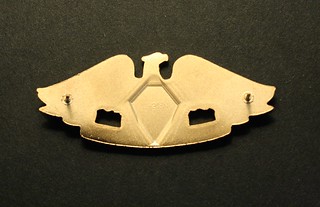 U.S. Naval Merchant Marine Reserve insignia.
U.S. Naval Merchant Marine Reserve insignia.Single construction.
Eagle stamped brass with gold-plate.
1939-1940.
badge: 2-3/4in from tip to tip of wings.
In October 1942, a curious chain of memoranda was passed between the New York State Maritime Academy Superintendent and various U.S. Navy officials. Prompted by Kings Point cadet uniforms having sewn on them a previously professional only device in preparation for a parade on the 24th of the month, the NYSMA Superintendent had a valid question, and perhaps potentially a little egg-on-face for his counterpart across Long Island Sound. The notes touched on the eligibility of cadets at the aforementioned academy to wear a relatively recent badge: the U.S. Naval Merchant Marine Reserve Insignia. This insignia came to be called the U.S. Naval Reserve Insignia, or simply the Sea Chicken.
(580) Dy
October 14, 1942
From: The Superintendent, New York State Maritime
Academy.
To: The Chief of Naval Personnel.
Via: The Commandant, Third Naval District.
Subject: Merchant Marine Reserve Insignia.
Wear On Academy Uniform.
Reference: (a) Art. 16-9 of Chapter XVI of U.S. Navy
Uniform Regulations, 1941.
1. Information is requested whether the insignia
described in reference (a) is authorized to be worn on
the dress uniform of cadets enrolled in this academy who
hold appointments as Midshipmen in the Merchant Marine
Reserve, U.S. Naval Reserve, and who do not hold licenses
issued by Marine Inspection Service.
/s/ Thos. T. Craven.
[Vice Admiral T. T. Craven, U.S.N.]
1st endorsemnet JJ55-3 DMq09:cs 19 October 1942. From: The Commandant, Third Naval District. To: The Chief of Naval Personnel. 1. Forwarded. 2. The Commandant considers that the Merchant Marine Reserve insignia is intended to give recognition to merchant marine officers employed by private companies who are members of the Naval Reserve, and, therefore, does not recommend that cadets enrolled in the New York State Maritime Academy be authorized to wear this insignia. /s/ Paul P. Blackburn, By direction.
26 October 1942
Pers-1016--KS
JJ55-3(1522)
From: The Chief of Naval Personnel.
To: The Superintendent,
New York State Maritime Academy,
Fort Schuyler, The Bronx, N.Y.
Via: The Commandant Third Naval District.
Subject: Merchant Marine Reserve Insignia - to be
worn by midshipmen, Merchant Marine
Reserve.
References: (a) Supt. N.Y.St.Mar.Acs.ltr (580)Dy
of Oct. 14, 1942.
(b) Art. 16-9, Uniform Regulations,
U.S. Navy.
Enclosure: (A) Copy of BuNav ltr. Nav-1644-XKS
(QR2(C)(66) of Oct. 4, 1941.
1. As midshipmen, Merchant Marine Reserve, at the State
Maritime Academies are required to wear a uniform
appropriate to an officer, and as these Academies are
under the supervision of the War Shipping Administration,
which succeeded to the training functions formerly
performed by the U.S. Maritime Commission, midshipmen,
Merchant Marine Reserve, under instruction at these
Academies, are authorized to wear the Merchant Marine
Reserve insignia on their Academy uniforms.
/s/ L. E. Denfield,
The Assistant Chief of Naval Personnel.
Apparently, the Maritime Academies had a friend in the Chief of Naval Personnel, as in 1942 the matter was settled in that all cadets may indeed wear the insignia. All of this begs the question: what was this insignia, that caused such a stir of interest among Naval and Maritime Academy officials?
The Merchant Marine Reserve had its beginnings in 1913 when US Congress wrote into law a reformulated the Naval Reserve Force. At the time, the Reserve was separated into five classes, and soon became six:
Class I: The Fleet Naval Reserve: Consisting of personnel having former active Naval Service.Class III, Naval Auxiliary Reserve, comprised of officers and unlicensed seamen, was the precursor of the Merchant Marine Reserve program, and the one for which the U.S. Naval Merchant Marine Reserve Insignia would ultimately be destined.
Class II: The Naval Reserve: Consisting of persons of the seagoing profession who had served at least two years aboard a vessel on the high seas or larger lakes.
Class III: Naval Auxiliary Reserve: Consisting of persons who had served or were serving in the Merchant Marine of the United States.
Class IV: Naval Coast Defense Reserve: Consisting of personnel capable of performing special and useful service in the time of war.
Class V: Volunteer Naval Reserve: Consisting of personnel qualifying for the other classes of the Reserve, who were willing to serve without pay in the time of peace.
Class VI: Naval Reserve Flying Corps: Consisting of personnel who were from the Naval Flying Corps.
Insignia for the Reserve was first prescribed in “Changes in Uniform Regulations United State Navy, 1913 No. 10” in 1915. This was the first official publication of distinctive uniform elements for the entire Naval Reserve. At the time, those Merchant Marine Officers in Class III wore their steamship line or company uniform with the Naval Reserve Force device on the collar of the “military coat,” or on the lapels of the “box coat.” This device was a miniature of the commissioned officers cap device. There were also special buttons worn on Merchant Marine uniforms. The button field was plain, with an anchor and the letters “U.S.” on either side of the shackle above the stock, and with the letters “N.R.” on either side of the shank between the stock and the flukes.
As authorized in 1938, the Merchant Marine Reserve insignia was composed of a gold embroidered bronze or gold plated metal pin consisting of a spread eagle surcharged with crossed anchors and shield 5/8in in height, 2-3/4in from tip to tip of wings; length of anchors 7/8in; and underset with 3/16 scroll bearing the letters “US” on one side of the shield and “NR” on the opposite side. Wearers were required to wear the Merchant Marine Reserve insignia on the left breast of their Merchant Marine uniform and nowhere else.
The 1930s was a turbulent time. The U.S. shipping industry was in free fall due to the Great Depression, with foreign firms having taken over most overseas and making strident end-runs in domestic shipping. As war erupted across Europe and Asia, the belligerent nations, which once carried the majority of U.S. trade, swept their ships into national service, leaving the U.S. both lacking in both ships and men. The Federal government stepped into the fray by subsidizing ship construction and encouraging the training of young men to enter the trade, and the U.S. Navy found itself looking for warm bodies to man its ships in the eventuality of war in Europe and in the Pacific. Naturally, the U.S. Navy looked to Nautical Schools and Merchant Marine Academies for potential manpower. Nevertheless, manpower could only be had with concessions from both sides: military and civilian.
The Navy Department acknowledges and commends the splendid results that have been achieved, as attested by the fine record of the graduates of these nautical schools at sea, and the success of many more in positions of high trust and responsibility in connection with the administration and operation of the maritime industry ashore.The conference resulted in the following: First, the curricula of the State nautical schools were extended with schools preparing young men not only for service in the American Merchant Marine but also in the United States Naval Reserve. The following nine naval subjects were added to the course of study: Navy Regulations, Naval Law, International Law, Types and Characteristics of Naval ships and aircraft, Tactics and Manoeuvering, Ship Drills, Gunnery, Communications and Damage Control. The instruction in these subjects was to be given the form of lectures by commissioned and active duty Naval officers. Second, the Bureau of Navigation, under the authority of the Secretary of the Navy, issued instructions to local Naval District Commandants providing for the admission of nautical school students in the Naval Reserve as Merchant Marine Cadets, in accordance with the Naval Reserve Act, approved June 25, 1938. Third, the Chief of Bureau of Navigation and the Chief of Naval Operations recommended to the Secretary of the Navy that appropriate steps be taken to secure from the Maritime Commission the allocation of funds for the construction of suitable vessels as replacements for the then present State schoolships, as necessary; these ships were to be of such a character as to be readily usable as naval auxiliaries in an emergency. The recommendation was immediately approved by the Secretary of the Navy. Thus was the inception of the Merchant Marine Midshipman Reserve program which provided the beginnings of Naval Science Program at the Maritime Academies. The New York State Maritime Academy was the first of the schools to open its doors to Naval instructors in 1939; by the end of the year, a big gun found its way to Fort Schuyler.
 |
| NYSMA cadets marching at World's Fair 1939. |
[...]There were 60 cadets serving as Midshipman, Merchant Marine Reserve, on active duty on Merchant Marine vessels taken over by the Navy.The school ships of the state maritime academies were not taken out of auxiliary status and activated; thus, students and non-Naval Reserve instructors remained unaffected. At the same time, with the allocation of government funds and provision of schoolships, schools (now academies) had their training programs vetted by the Maritime Commission. However, these same instructors became inducted into the Maritime Commission’s uniformed training organization – the Maritime Service. With the final action, came membership in the Merchant Marine Reserve. After the formal declaration of war on December 8, 1941:
The Supervisor, three Assistant Supervisors, the three District Cadet Training Instructors, the three Commanding Officers of Cadet Schools, and almost all Cadet Training Instructors in districts and at Cadet Schools hold licenses as officers of the Merchant Marine, and commissions in the United States Naval Reserve. On January 6, 1942, the Navy ordered these Naval Reserve officer instructors to active duty status.It may be due to creative thinking by a Navy supply officer, a Maritime Commission purser or New York uniform supply house salesman, but Corps of Cadets members began to sporadically wear the insignia in 1940. This would be due to a perceived de facto, and not codified de jure reserve status of the cadets and cadets holding a nominal officer status. Ship officers, as defined by U.S. law, are those sailing under or holding a license as issued by the US Bureau of Marine Inspection. Nautical tradition held that cadets were officers-in-training with rank below the lowest officer grade but rating privileges held by a mid-level unlicensed mariner. Some shipboard cadets, known as "cadet officers", previously held licenses but did not sail under them, and could conceivably claim Merchant Marine Reserve status. Others cadets perhaps (and did) don the insignia while on ships activated during the first emergency periods. Either way, on paper this insignia was only valid while in active employ aboard merchant vessels. If a ship were seized directly by the Navy, cadets became midshipmen - as happened to some merchantmen namely oilers and Maritime Commission designed freighters - and were officially barred from wearing the insignia on their uniforms aboard ship. Moreover, the regulations did not state that the insignia was not for midshipmen, rather licensed officers.
It is worth mentioning that the personnel of the Merchant Marine, Government Marine (e.g. Army Transport Service and Coast and Geodetic Survey) and Armed Marine (US Navy and Coast Guard) shared similar trades, but diverged in organizational culture. The Merchant Marine sailor of the late 1930s suffered through the deprivations of the Great Depression and union struggles against shipowners. Except for ship officers, many held no particular allegiance to ship or employer. With the Jones Act, foreign colleagues were ejected from vessels, thereby removing skilled labor, and introducing gaps in overall ship manning. Depending on the union, mariners could be militantly left-leaning or thoroughly apathetic in their daily struggle to make a living. The Navy rank and file also came from the same lower-middle-class background as the merchant sailors – although tempered by grueling training and autocratic hierarchy. Men in the Regular Navy took a dim view of civilians and reservists on shore and in their midst. Many officers of the former worked their way from the deck to the pilothouse; a small number came from the nautical schools and academies. Most active Navy officers came from the Naval Academy where they were molded and inducted into an efficient warrior class. It is at this intersection where academy graduates and the service found themselves: outsiders making an entrance into an unforgiving hierarchy bound by custom and regulation. It is no surprise that despite coexisting on the same waterfronts, the two groups held each other at arm’s length.
State maritime academy cadets did not wear the insignia at any point up to October 1942; graduating class photos attest to this fact. The lack of insignia would not be due to the absence of a Naval Science curriculum; a course of study created by a gentlemen’s agreement in 1938, and put into practice in 1939 – which coincidentally was the same year that the Corps of Cadets was invited to the NYSMA grounds by then Superintendent Tomb. Nor did not having Midshipmen, Reserve status; which state cadets were afforded in August 1942. Nor even lack of connection to the Maritime Commission; with accepting federal monies and federal ships with which came Federal curricula and staff. It would be due to a creative reading of provisions of wear of the Merchant Marine Reserve insignia did the Corps of Cadets come to wear the insignia; and a rather conservative reading that state cadets did not. It is notable in that the wide-spread distribution of the insignia to cadets only came with Tomb coming to Kings Point a month after its inception as the first superintendent in April 1942.
Kings Point, from its outset, was linked strongly to NYSMA, although both diverged in raison d’être. The NYSMA was created to educate young men from New York for the maritime industry operating out of the Port of New York. The Maritime Commission Corps of Cadets, to bring young men from around the country without access to state schools, the opportunity to become licensed officers of the subsidized blue-water U.S. Merchant Marine. Thus, having looked at the successful model of staffing, cadet structure and uniforming, the early Merchant Marine Academy had similar components as the NYSMA. There was a strong cross-pollination of Kings Point and NYSMA instructors and potential students, Kings Point copying NYSMA regimental and honor system and using practically the same uniforms. At the permanent establishment of the NYSMA at Fort Schuyler, Tomb hailed the facility as being the future Annapolis of the U.S. Merchant Marine; after his transfer to Kings Point, he hailed the Merchant Marine Academy as the same. As such, there existed a friendly rivalry between the two. The mass distribution of the badge, and with it, a perceived honor status, can be viewed as a slight affront to – perhaps even antagonizing – the older school. NYSMA was hampered by New York bureaucracy and its expansion plans stymied by Federal land use provisos and local political posturing. In this light, the Superintendent’s letter makes sense; as does that of the Commandant, Third Naval District. In essence, if the upstart institution may have the insignia, then so should NYSMA – or vice-versa. Whatever the case may be, all maritime academies, having their cadets subject to Midshipmen, Reserve status and the blessing of the Chief of Naval Personnel secured the insignia on October 26, 1942 – but not in time for the big New York Navy Day parade just two days prior. Thus, as an administrative matter in 1942, the Chief of Naval Personnel authorized Merchant Marine Midshipmen, USNR, under instruction at the state maritime academies, to wear the Merchant Marine Insignia on their academy uniforms, since these academies were under the supervision of the War Shipping Administration.

Post-war saw a change in the military establishment’s view of the role of the Merchant Marine as an auxiliary and the desirability of Merchant Mariners in its reserves. In 1951, the Navy regulations were revised, and only cadets who were Midshipmen, USNR, at the U.S. Merchant Marine Academy were allowed to wear the insignia on their academy uniforms – not on their uniforms if shipping out or serving on commissioned Naval vessels. With the 1952 abolition of the Merchant Marine Reserve under Public Law 467 by the 82nd Congress, came the resultant removing Midshipman, USNR status from Merchant Marine Academy cadets and therefore the eligibility of wearing the Merchant Marine Reserve Insignia. Despite being granted Federal status, having a military character and Naval Science courses, Merchant Marine Academy cadets became simply “officer candidates.” This touched off a controversy in that one of the selling points in a Merchant Marine Academy (state or Federal) education were draft-deferment or exemption and the possibility to be granted a commission in the U.S. Navy upon graduation. Gone was the pin, escape clause, and privileges. However, due to an administrative oversight, cadets continued wearing the badge until mid-1954 with its overall disappearance on cadet uniforms in 1956. Apparently, the California Maritime Academy administration must not have gotten the memo, as in 1958, 18 of 50 graduates were sporting the insignia; in 1959, however, the insignia was absent. 1964 saw with the re-institution of the merchant marine naval reserve status at Kings Point; only to have it abolished in 1965 and superseded by a Naval Reserve commission for the class of 1968 with accompanying badge reappearance.
The state academies had to wait until 1977 when their cadets became Midshipmen, USNR, of the Naval Reserve Officer Training Corps (NROTC) to pin the insignia back on their uniforms. Beginning in 1980, those cadets who signed a Training and Service Agreement and became Midshipmen, USNR, were also authorized to wear the Merchant Marine Reserve Insignia. Up until recently, all Midshipmen USNR enrolled in maritime training programs leading to a merchant marine license, were eligible to wear the insignia.
With the start of the Merchant Marine Reserve, U.S. Naval Reserve (MMR, USNR) program in 1977, the insignia was authorized for the first time for wear on the Navy uniform of officers by this officer community. The requirement for wear was published in the 1978 Navy Uniform Regulations:
To be eligible to wear this insignia, Naval Reservists must meet one of the following requirements:
a. Be licensed merchant marine officers who sail on their license at least four months every two years and are members of the MMR , USNR program.
b. Be officers in the Maritime Service holding merchant marine licenses and who are instructors at Federal, State and Regional Academies, and at industry, or union maritime schools who are members of the MMR, USNR, program.
c. Be merchant marine officers holding licenses as Chief Mate/First Assistant Engineer/Radio Officer or higher, with eight years of licensed sailing experience and currently employed in a maritime related position ashore, and who are members of the MMR, USNR program.

On June 10, 2011, a change in the Merchant Marine, U.S. Naval Reserve program resulted in it being called the Strategic Sealift Officer program, and along with it a replacement of insignia (OPNAVINST 1534.1D § 12.b.5). The new device, Strategic Sealift Officer Warfare Insignia, will be available in May 2012. Despite patterns yet to be struck:
The SSOWI is approved for wear by officers who have successfully completed the qualification requirements outlined in OPNAVINST 1534.1D. The insignia is gold in color and is two and three-quarter inches by seven eighths of an inch in dimension, reflecting the background of an eagle from the USS Constitution's stern, crossed naval officer swords and a U.S. shield with fouled anchor from the U.S. Merchant Marine flag. The SSOWI will be available in two sizes (normal and miniature). The normal size SSOWI shall be worn on all uniforms, less dinner dress. The miniature SSOWI shall be worn with miniature medals on dinner dress uniforms (NAVADMIN 164/12 § 2.B).Good to know, I guess. To the way of the shadow box and collector the illustrious "Sea Chicken" - once symbol of the larger debate of how Merchant Mariners figure in U.S. National Defense - shall go.
References
The Commonwealth of Massachusetts Department of Education. Public Document 42: III Annual Report of the Commissioners of the Massachusetts Nautical School for the Year Ending November 30, 1938. Boston: Commonwealth of Massachusetts, 1938.
U.S. Congress. Naval auxiliaries for use in the Merchant marine. Hearings before a special subcommittee of the Committee on Naval Affairs, House of Representatives, Sixty-third Congress, second session, on S. 5259, a bill to establish one or more United States Navy mail lines between the United States, South America, and Europe; and H.R. 5980, a bill to authorize the President of the United States to build or acquire steamships for use as naval auxiliaries and transports, and to arrange for the use of these ships when not needed for such service, and to make an appropriation therefor. Washington D.C.: GPO, August 1914.
Department of the Navy. "STRATEGIC SEALIFT OFFICER PROGRAM." OPNAVINST 1534.1D § 12.b.5. Washington D.C., June 10, 2011.
Department of the Navy. "STRATEGIC SEALIFT OFFICER WARFARE INSIGNIA (SSOWI)." NAVADMIN 164/12 § 2.B. Washington D.C., May 18, 2012.
Original design of insignia as found in Uniform Board notes 1938.
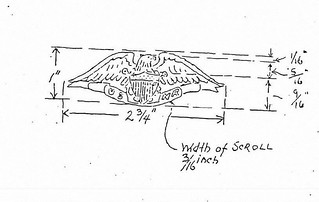
Dating the Merchant Marine Reserve Insignia is not very tricky. There are two main variations in design and two types: stamped metal and embroidered. The former continued to be worn until 2012 with planned phase-out in 2013. The embroidered device fell out of use in the mid-1950s along with all embroidered badges on US Navy officer uniforms. It has the interesting quality of being one of the longest-lived badges in the Navy and least awarded.
1938-1941
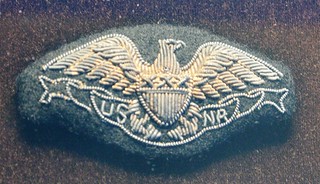

The first pattern, as noted in the text is the own left-facing eagle. It was issued until mid-1941.
This specific item is part of a Panama Railroad Steamship Company pursur grouping. It is displayed along with a Merchant Marine Defense Ribbon; meaning it was worn at least until mid-Second World War.
1939-1940


This is a gold-plated pin from the pre-war period. It was issued prior to mid-1941. The insignia lacks a hallmark; as is the case with many pre-war items.
This item is of particular interest as it comes from a U.S. Maritime Commission Corps of Cadets cadet grouping dating to the regiment's sojourn at Fort Schuyler. Of interest is the fact that the original owner was relatively old at the time of enrollment, being 22; meaning he was probably a "cadet officer" and sailed under his license until Navy enlistment in 1943. At the time college students were less apt to drop their course of study to join the Corps of Cadets, with hawsepipers making up a handful of cadets during this period.
1942

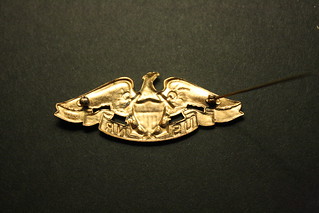
This is a Vanguard insignia that comes from a U.S. Merchant Marine Academy graduate that ended up being a junior radio officer; or a radio officer attached to the U.S. Merchant Marine Academy. Further research is required on my part.
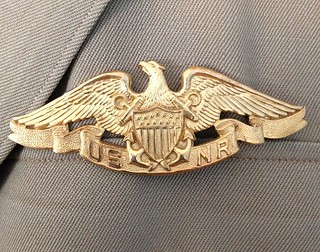
1943

The above is from March 1943 granted after the Acceptance of Appointment as Midshipman, Merchant Marine in the U.S. Naval Reserve.

1944


Embroidery of the insignia was still of a high standard in 1944. Notice the overall difference with...
1945
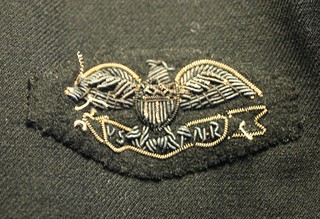
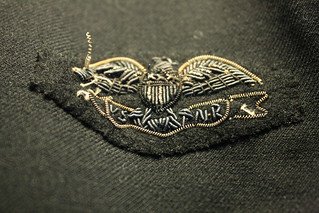
1946
The following two insignias are from 1946. Do note the difference in embroidery.
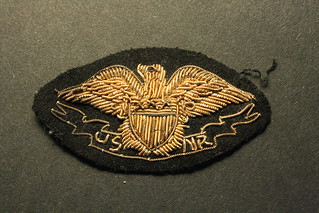
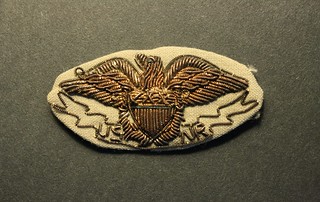
The first is on a black wool backing for wear with the USMMA dress jacket as well as on the Service Dress Blue coat.
The second is on a khaki twill backing; it was sewn on the khaki working coat. This is an unusual example, as previously, cadet-midshipmen were directed to wear the pin device on khaki - khaki was commonly steamed, as opposed to dry-cleaned like the worsted wool. When the pin was reinstated, this failed experiment was not repeated, as khaki working coats were no longer in a cadets-midshipman's sea bag.
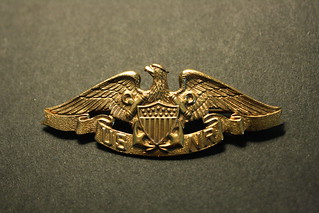
The third device, with a Coro hallmark, also dates from the same period and was worn on dress whites of the period.

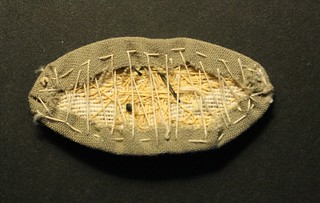
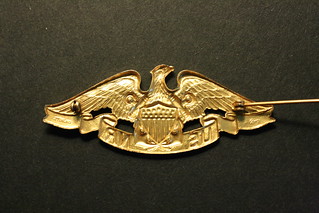
2010

The last item is a Vanguard insignia from 2010. It was manufactured by International Insignia in Providence, Rhode Island. Many Vanguard insignia items are actually jobbed out to International Insignia as Vanguard in recent years has apparently found contracting low volume orders more cost effective than striking them inhouse. Notable would be the occasional IOH I-21 as opposed to V-21-N hallmark.
